Family : Orchidaceae

Text © Prof. Pietro Pavone

English translation by Mario Beltramini
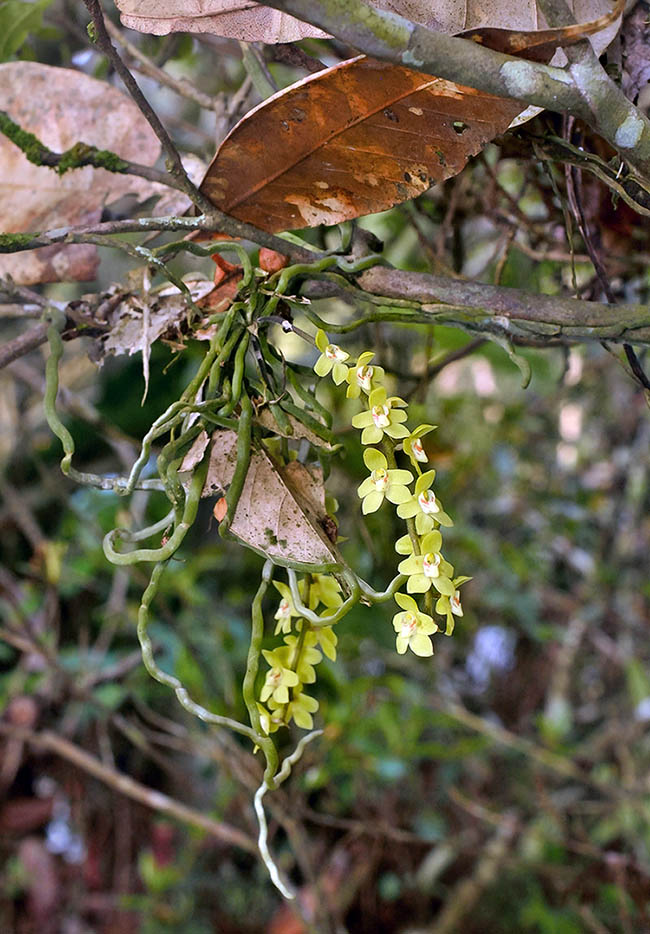
Chiloschista segawae is a small leafless epiphyte orchid with flat roots that make the phosynthesis © Kuo-Chu Yueh
Chiloschista segawae (Masam.) Masam. & Fukuy. (1938) is a species of the family Orchidaceae, subfamily Epidendroideae, Tribe Vandeae, Subtribe Aeridinae.
It is found in central-southern Taiwan, in the tropical rainforests at altitudes from 700 to 1000 metres, as an epiphyte of small and medium size, on the trunks of the trees.
It is commercially protected and as such has been inserted in the Appendix II of Washington Convention (CITES) that has the aim of protecting the animal and vegetable species under risk of extinction, forbidding their export and detention.
The genus Chiloschista was described by John Lindley (1799 – 1865) in Edwards’s Bot. Reg. vol. XVIII (1832).
The name comes from the Greek χεῖλος, (cheilos), lip and σχιστός (schistós), divided, separated, with reference to the structure of the labellum that in this taxon has a saccate conical shape.
While describing it, Lindley referred to the characters of the species, Epidendrum usneoides, whose distribution area extends from the Himalaya up to Myanmar, and that David Don (1799-1841), Scottish botanist, in 1825 had included it in the genus Epidendrum.
However, Lindley thought that this species was not included in the characters distinctive of the genus Epidendrum and for this purpose, in 1832, created the genus Chiloschista to include Chiloschista usneoides (D.Don) Lindl. that, in such a way, represents the type (typus) of the genus.
Chiloschista segawae was formally described for the first time in 1934 by Genkei Masamune (1899-1993) as Sarcochilus segawae, whose diagnosis was published on Trans. Nat. Host. Soc. Formosa 24:212 (1934).
The species was dedicated to the Japanese botanist Sokichi Segawa (1904-1960). However, in 1938, the Japanese botanists Genkei Masamune (1899-1993) and Noriaki Fukuyama (1912-1946), more correctly, transferred it into the genus Chiloschista giving it the name by which it is validly called today.
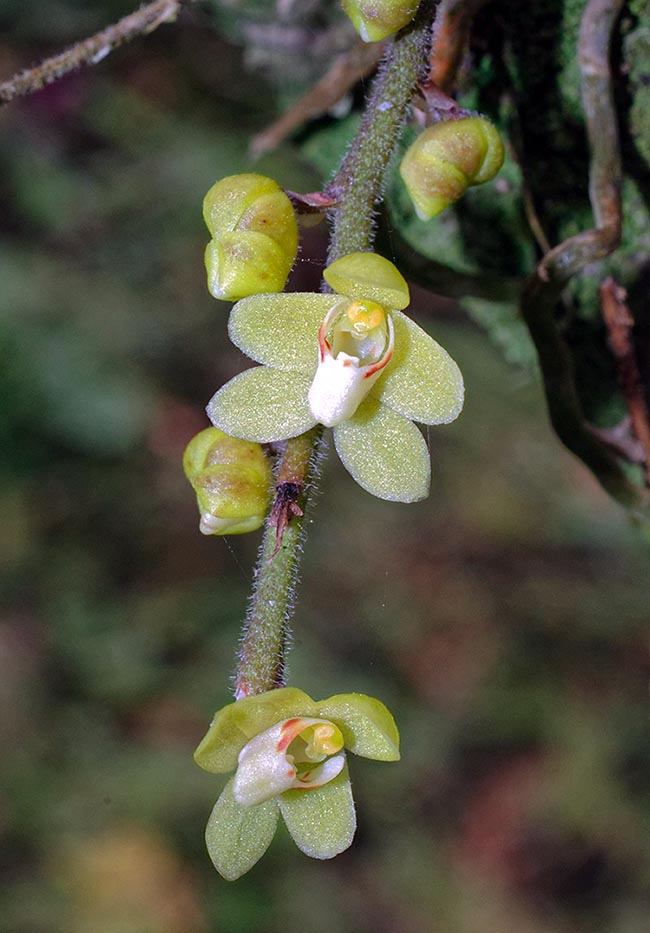
It grows at 700-1000 m of altitude in centre-south Taiwan forests with often pendulous racemose inflorescences © Kuo-Chu Yueh
Commonly called “Segawa Chiloschista”, in its origin sites it is called 大蜘蛛蘭 (great spider orchid) due to the characteristic arrangement of its roots on the trunks.
Chiloschista segawae is an epiphyte herbaceous plant, leafless, with many flattened, up to 35 cm long, roots that radiate from inconspicuous stems.
They are aerial roots with chloroplasts able to perform the photosynthesis of CAM (Crassulacean Acid Metabolism) type and to absorb the water also from the air thanks to their spongy and permeable surface layer, formed by dead cells, called velamen.
The velamen, formed by dead epidermal cells, is a spongy tissue and serves as temporary storage of the water that is slowly absorbed by the conductor cells in order to be distributed to the plant.
When it dries up, its empty cells slow down the loss of water, furnishing a mechanical protection against the drying.
Moreover, they block the UV radiation and prevent the collapse and death of the root cells.
These peculiarities are much more pronounced within the leafless epiphytic plants.
The often pendulous inflorescence is racelous, 5-15 cm long with 6-15 flowers having thickly pubescent peduncle and rachis.
The floral bracts are ovate-triangular, 3-5 mm, membranous, glabrous or poorly pubescent.
The flowers, resupinate and slightly fleshy, measure about 9 mm and are of whitish green or yellowish colour, at times with red-brown spots close to the base of the sepals and the petals.
However the colour of the flower may vary for the spots, their position and for the intensity of the colour.
The dorsal sepal is widely elliptical (3-5 x 2,5-4 mm), glabrous or little pubescent outside. The lateral sepals are slightly oblique, ovate or elliptical (4,5-6 x 3,(-4 mm), little pubescent near the outer base.
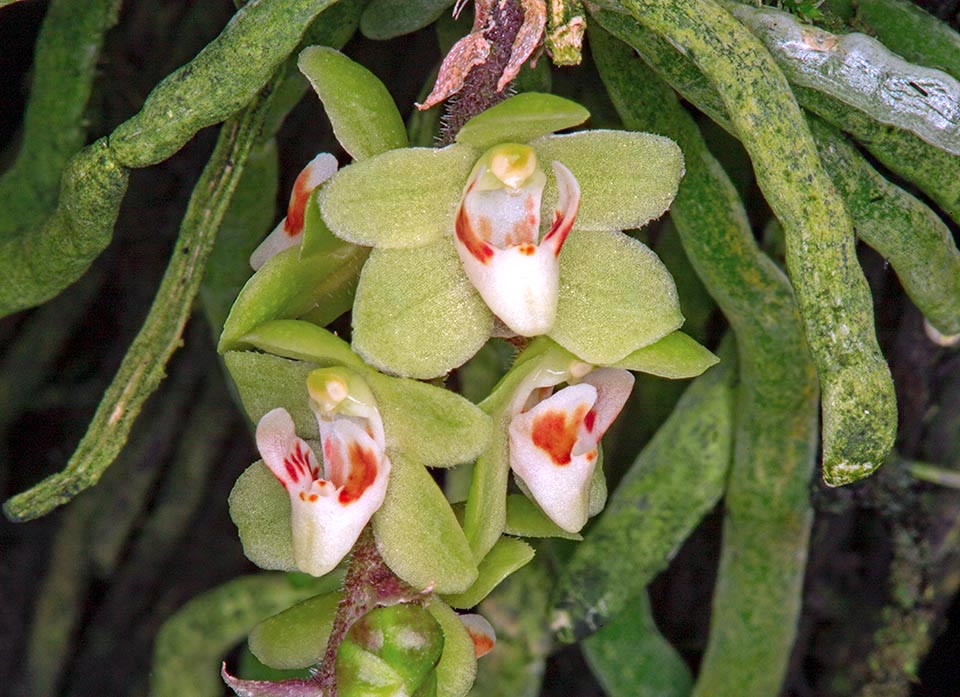
The slightly fleshy flowers measure about 9 mm and are whitish green or yellowish, at times with red-brown spots near the base of the sepals and petals © Giuseppe Mazza
The petals are elliptical (4-6 – 3,5-4 mm), obtuse. The labellum, articulated with the foot of the column, is trilobate and is 5-6 mm long.
The lateral lobes are erect, with brown stripes, and the median lobe is small with a sac-like base (2-3 mm) with bilobed longitudinal callus, pubescent and grooved running along the bottom of the sac. The column (gymnostemium) is short, 1 mm long with a 3,5 x 2 mm broad foot.
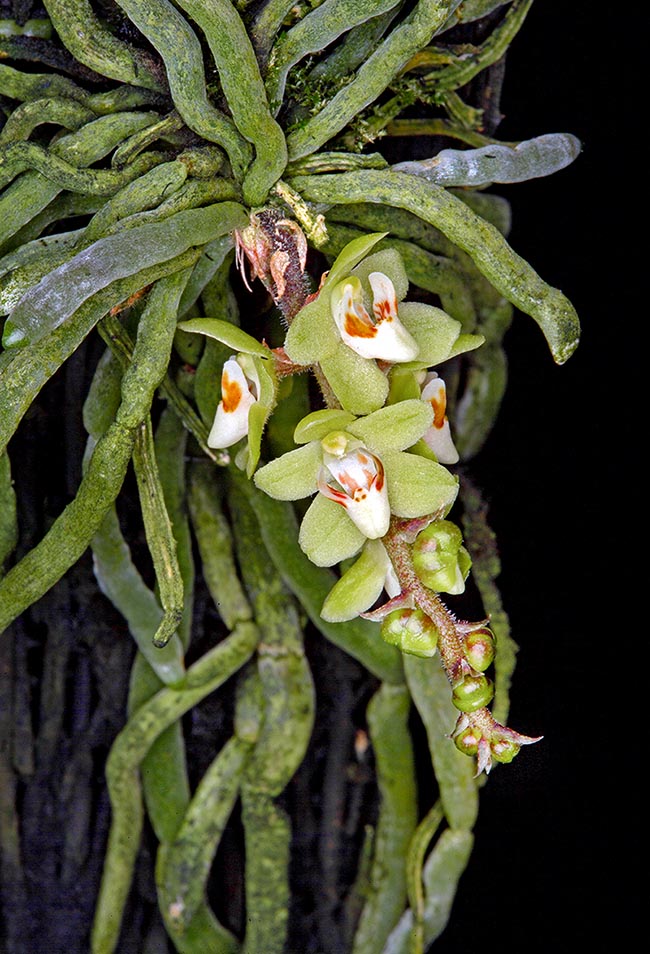
The 5-15 cm long graceful inflorescence may bear 6-15 flowers with thickly pubescent peduncle and rachis © Giuseppe Mazza
The rostellum is well developed, semicircular, prominent. The stigma is placed inside an ample cavity.
The anther is semicircular, about 1 mm long, with a long filament stuck on both sides.
The pollinaria are 2, each one with 2 unequal septa, globose, yellow, having a peduncle (caudicle) and stuck to the glutinous gland (viscidium) relatively big in order to better adhere to the body of the pollinators.
The blooming takes place in early spring (March-April).
Most probably, the pollination is done by the autochthonous bees.
The linear-clavate fruits are capsules, 2,5 cm long with numerous small seeds.
A recent study done on the congeneric species, Chiloschista parishii Seidenf. (1988), also leafless, has evidenced the presence of a community of cyanobacteria associated to the aerial roots and formed mainly by self-fixing filamentous species. These belong to the orders Nostocales, Synechococcales and Oscillatoriales.
It has also been found that some species belonging to the genera Oscillatoria, Leptolyngbya and Komarekiella live closely linked to the surface of the aerial roots and form, together with heterotrophic bacteria that are immersed in their mucilage, a biofilm layer that supplies nutrients, including compounds containing nitrogen very useful for plant growth.
It has also been noted that in the epiphytic orchids exists an abundance of bacteria of endophytic nature that penetrate through the velamen up to the cortical parenchyma of the roots.
In such a way the epiphytic orchids have been able to host a microbial community beneficial for them formed by microorganisms able to fix the nitrogen and to produce phytohormones, like the auxin (indole-3-acetic acid) and the gibberellins that regulate the growth and the flowering.
The studies on the interactions between orchids and symbiont microorganisms are of particular interest for better knowing how to conserve them in nature but also in greenhouse conditions.
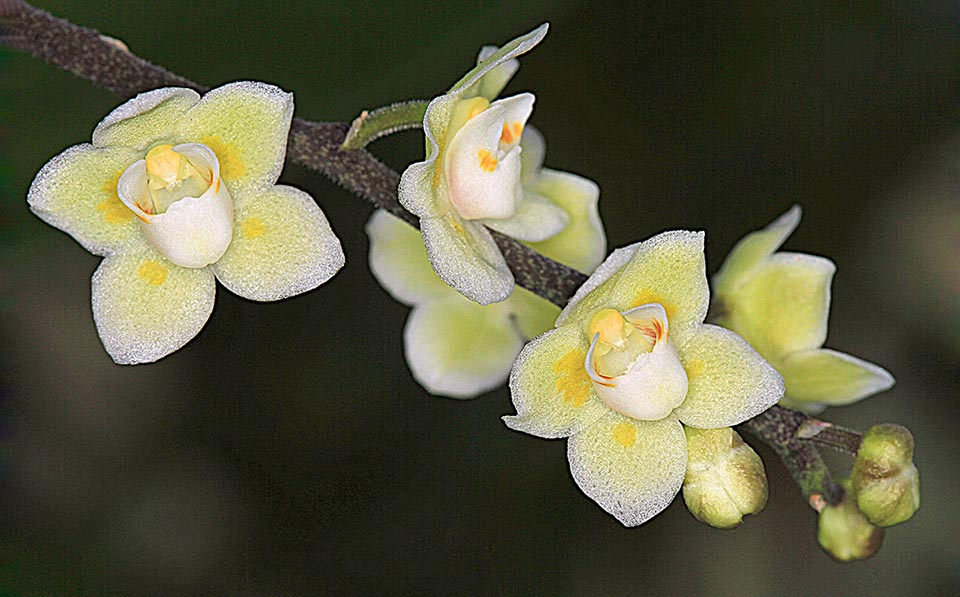
Very appreciated by collectors, requires moderate shade and humid environments with cool to averagely warm temperatures © Branka Forscek
The understanding of diversity and of the mechanisms of the interactions of the host with the associated bacteria living in the roots of the orchids ensures the profitable and stable growth of rare species, among which the orchids without leaves and buds have become some of the plants at bigger risk of extinction.
Chiloschista segawae can be reproduced by germination of ripe seeds or immature in vitro.
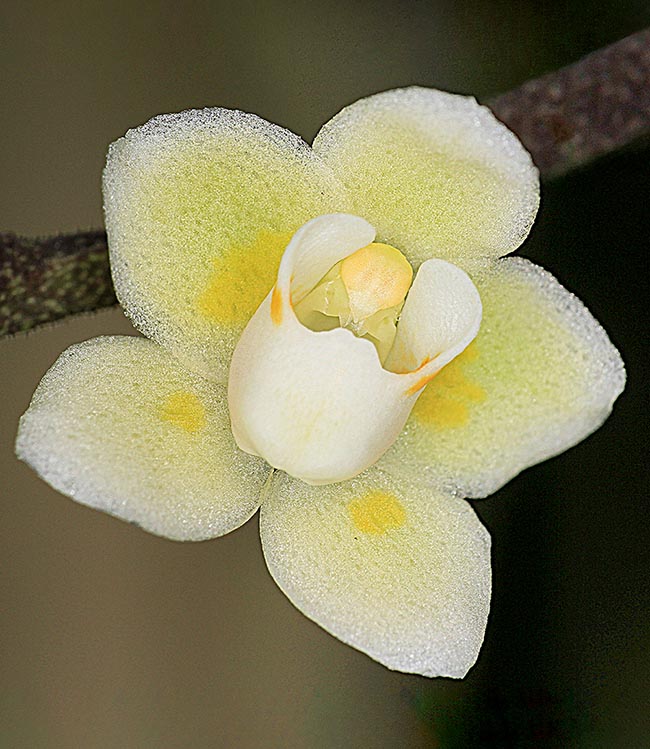
A mini orchid that can give great satisfactions with flowers not less elegant than those sold by the florists do sell © Branka Forscek
For a good cultivation it is good to place the plants in moderate shade and to expose them to cool to averagely warm temperatures.
They can be cultivated on well-draining substrata such as tree fern fibers, bark of fir or moss of sphagnum, but it is also possible to mount them on cork rafts, on wooden boards or on trunks, keeping in mind the the first months of planting are very critical to their development.
Once this period has been overcome, the plants adapt and consequently the risk of losses decreases a lot.
As they require high humidity, it is necessary to do frequent nebulizations and place the plants in a ventilated place. Between the waterings one has to wait for the roots to dry up.
During the season of growth, in summer, the frequency of the irrigations must be increased whilst the same is to be reduced during the winter resting time.
The plants are to be fertilized from spring up to the whole summer radically with mineral fertilizer every two to three weeks.
Synonyms: Chiloschista hoi SSYing (1987); Chiloschista segawae f. taiwaniana (SSYing) SSYing (1990); Chiloschista segawae var. taiwaniana SSYing (1977); Sarcochilus segawae Masam. (1934); Thrixspermum segawae (Masam.) Masam. (1934).
